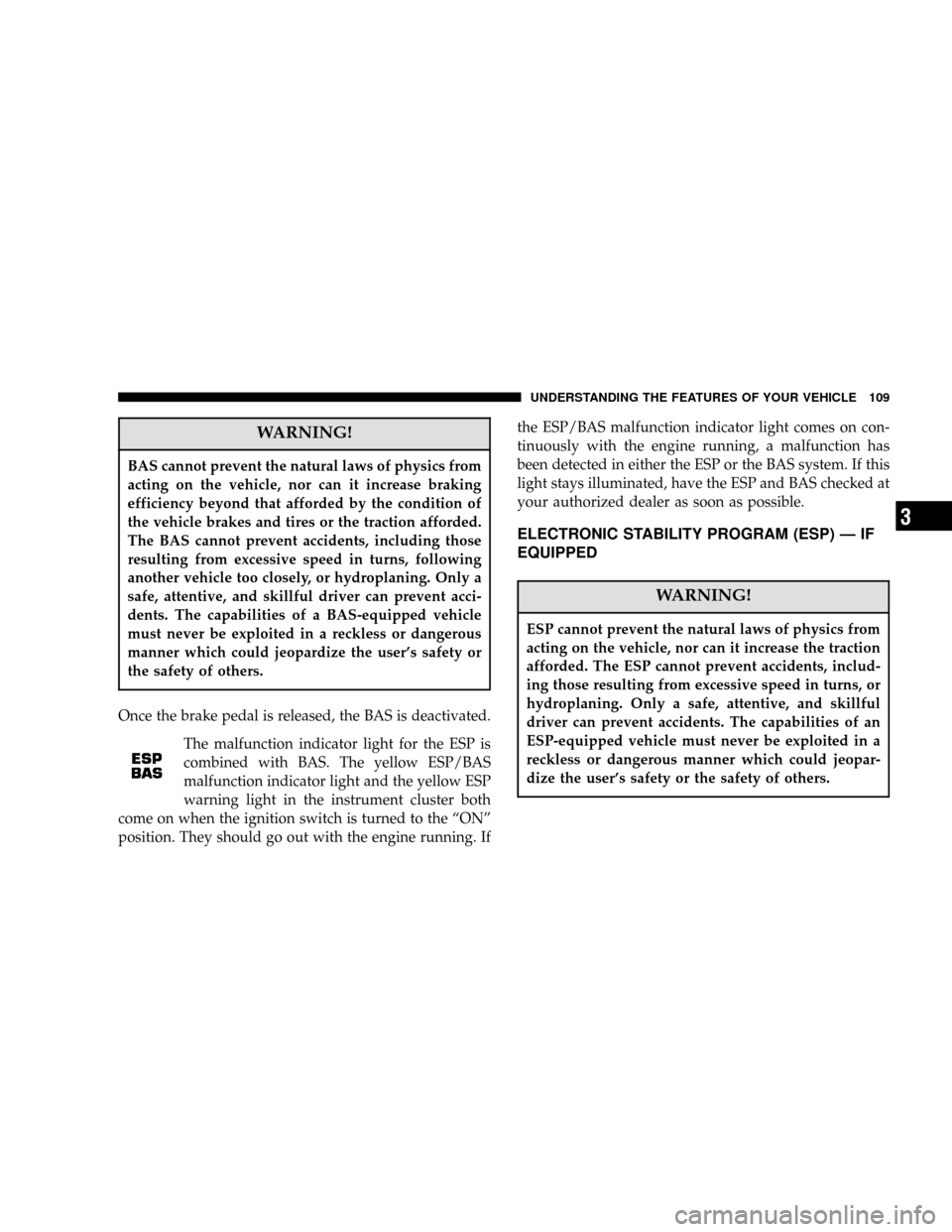DODGE CHARGER 2006 6.G Owners Manual
Manufacturer: DODGE, Model Year: 2006, Model line: CHARGER, Model: DODGE CHARGER 2006 6.GPages: 368, PDF Size: 6.13 MB
Page 101 of 368

Automatic Headlights—If Equipped
This system automatically turns your headlights ON or
OFF based on ambient light levels. To turn the system
ON, rotate the headlight switch counter-clockwise to the
AUTO (A) position. When the system is ON, the Head-
light Time Delay feature is also ON. This means your
headlights will stay ON for up to 90 seconds after you
turn the ignition switch OFF. To turn the Automatic
System OFF, move the headlight switch out of the AUTO
(A) position.
NOTE:The engine must be running before the head-
lights will come ON in the Automatic mode.
Headlight Switch
UNDERSTANDING THE FEATURES OF YOUR VEHICLE 101
3
Page 102 of 368

Headlights On With Wipers (Available with Auto
Headlights Only)
The headlights will turn on approximately 10 seconds
after the wipers are turned on if the headlight switch is
placed in the AUTO position. The headlights will also
turn off when the wipers are turned off if they were
turned on by this feature. This feature can be turned on or
off using the Electronic Vehicle Information Center
(EVIC)—If equipped. Refer to”Headlights On With
Wipers”in the Electronic Vehicle Information Center
section of this manual for details.
Daytime Running Lights (Canada Only)
The high beam headlights will come on as Daytime
Running Lights whenever the ignition switch is on, the
headlights are off, and the parking brake is off. The
headlight switch must be used for normal night time
driving.
Lights-on Reminder
If the headlights or parking lights are on after the ignition
is turned OFF, a chime will sound to alert the driver
when the driver’s door is opened.
Headlight Time Delay
This feature provides the safety of headlight illumination
for 90 seconds (programmable) when leaving your ve-
hicle in an unlighted area.
To activate the delay feature, turn off the ignition switch
while the headlights are still on. Then turn off the
headlights within 45 seconds. The 90 second delay inter-
val begins when headlight switch is turned off. If the
headlights or park lights are turned back on or the
ignition switch is turned on, the delay will be cancelled.
If the headlights are turned off before the ignition, they
will turn off in the normal manner.
NOTE:The lights must be turned off within 45 seconds
of turning the ignition off to activate this feature
The Headlight delay time is programmable on vehicles
equipped with the Electronic Vehicle Information Center
(EVIC). Refer to“Delay Turning Headlights Off”in the
Electronic Vehicle Information Center section for details.
102 UNDERSTANDING THE FEATURES OF YOUR VEHICLE
Page 103 of 368

Fog Lights—If Equipped
The front fog light switch is on the headlight
switch below the dimmer control. To activate the
front fog lights, turn on the parking lights or the
low beam headlights and press the fog light switch.
NOTE:The fog lights will operate with the low beam
headlights, or parking lights on. However, selecting the
high beam headlights will turn off the fog lights.
Turn Signals
Move the Multi-Function Lever up or down and the
arrows on each side of the instrument cluster flash to
show proper operation of the front and rear turn signal
lights. You can signal a lane change by moving the lever
partially up or down without moving beyond the detent.
Releasing the lever at the detent will provide 3 flashes.
If either light has a very fast flash rate, check for a
defective outside light bulb. If an indicator fails to light
when the lever is moved, it would suggest that the fuse
or indicator is defective or there may be a circuit failure.
NOTE:The message“Turn Signal On”will appear in
the electronic vehicle information center (EVIC)—if
equipped, and a continuous chime will be heard when
the vehicle has been driven more than 1 mile (1.6 km)
with either turn signal on.
Highbeam/Lowbeam Select Switch
Push the Multi-Function Lever away from you to switch
the headlights to HIGH beam. Pull the Lever towards
you to switch the headlights back to LOW beam.
Flash to Pass
You can signal another vehicle with your headlights by
lightly pulling the Multi-Function Lever toward you.
This will cause the headlights to turn on at high beam
and remain on until the lever is released.
UNDERSTANDING THE FEATURES OF YOUR VEHICLE 103
3
Page 104 of 368

WINDSHIELD WIPERS AND WASHERS
The wipers and washers are operated by the
multi-function lever. The lever is located on the
left side of the steering column. Rotate the end of
the control lever to select the desired wiper speed.
CAUTION!
Turn the windshield wipers off when driving
through an automatic car wash. Damage to the
windshield wipers may result if the wiper switch is
left in any position other than OFF.
Windshield Washers
To use the front washer, push the lever in and hold while
spray is desired. If the lever is released while in the delay
range, the wiper will operate for two wipe cycles after the
lever is released, and then resume the intermittent inter-
val previously selected.
If the lever is pushed while in the OFF position, the
wipers will operate for two wipe cycles, then turn OFF.
Windshield Wiper/Washer Control
104 UNDERSTANDING THE FEATURES OF YOUR VEHICLE
Page 105 of 368

Mist Feature
Push the wiper lever in to activate a single wipe to clear
off road mist or spray from a passing vehicle. As long as
the lever is pushed in, the wipers will continue to
operate.
Windshield Wiper Operation
Rotate the end of the lever to the second detent for Low
speed wiper operation, or to the third detent for High
speed operation.
Intermittent Wiper System
Use the intermittent wiper when weather conditions
make a single wiping cycle, with a variable pause be-
tween cycles, desirable. Rotate the end of the lever to the
first detent position, then turn the end of the lever to
select the desired delay interval. There are 6 possible
delay wiper positions. The delay can be regulated from a
maximum of approximately 23 seconds between cycles,
to a cycle every second.
Adding Washer Fluid
The windshield washer fluid reservoir is located in the
front of the engine compartment on the passenger side of
the vehicle. Be sure to check the fluid level at regular
intervals. Fill the reservoir with windshield washer sol-
vent (not radiator antifreeze) and operate the system for
a few seconds to flush out the residual water.
Windshield Washer Fluid Reservoir
UNDERSTANDING THE FEATURES OF YOUR VEHICLE 105
3
Page 106 of 368

The washer fluid reservoir will hold a full gallon of fluid
when the message“Low Washer Fluid”appears in the
Electronic Vehicle Information Center (EVIC)—if
equipped.
TILT/TELESCOPING STEERING COLUMN
Unlock the steering column by pulling out the handle
located directly below the column. To tilt the column
move the steering wheel up or down as desired. To
lengthen or shorten the steering column pull out or push
in the steering wheel. Lock the steering column in
position by pushing the handle in until it fully engages.
WARNING!
Do not adjust the steering wheel while driving. The
telescoping adjustment must be locked while driv-
ing. Adjusting the steering wheel while driving, or
driving without the telescoping adjustment locked
could cause the driver to lose control of the vehicle.
Tilt Steering Column Control
106 UNDERSTANDING THE FEATURES OF YOUR VEHICLE
Page 107 of 368

TRACTION CONTROL SYSTEM (TCS)—IF
EQUIPPED
WARNING!
TCS cannot prevent the natural laws of physics from
acting on the vehicle, nor can it increase the traction
afforded. The TCS cannot prevent accidents, includ-
ing those resulting from excessive speed in turns, or
hydroplaning. Only a safe, attentive, and skillful
driver can prevent accidents. The capabilities of a
TCS-equipped vehicle must never be exploited in a
reckless or dangerous manner which could jeopar-
dize the user’s safety or the safety of others.
The traction control system (TCS) warning
light is located in the instrument cluster. The
TCS light will flash as soon as the tires lose
traction and the wheels begin to spin. This
indicates that the TCS system is active. If the TCS
warning light begins to flash during acceleration, ease up
on the accelerator and apply as little throttle as possible.
Be sure to adapt your speed and driving to the prevailing
road conditions. When the TCS warning light is illumi-
nated continuously, the TCS is switched off. To return to
the enhanced vehicle stability offered by TCS, press the
traction control switch (the TCS warning light in the
instrument cluster goes out). Avoid spinning one drive
wheel. This may cause serious damage to the drive train.
The traction control switch is located on the center of the
instrument panel. To turn the traction control system OFF
press the traction control switch until the traction control
Indicator in the instrument cluster lights up.
UNDERSTANDING THE FEATURES OF YOUR VEHICLE 107
3
Page 108 of 368

To improve the vehicle’s traction when driving with
snow chains, or starting off in deep snow, sand or gravel,
switch off the TCS system by pressing the traction control
switch.
To turn the system back ON, press the traction control
switch a second time until the traction control Indicator
turns OFF.NOTE:
•
The traction control system comes on each time the
ignition switch is turned ON. This will occur even if
you used the button to turn the system OFF.
•The Traction Control system will make buzzing or
clicking sounds when in operation.
BRAKE ASSIST SYSTEM (BAS)—IF EQUIPPED
BAS is standard on vehicles equipped with electronic
stability program (ESP). The BAS is designed to optimize
the vehicle’s braking capability during emergency brak-
ing maneuvers. The system applies optimum pressure to
the brakes in emergency braking conditions than might
otherwise be afforded solely by the driver’s braking style.
This can help reduce braking distances. The BAS comple-
ments the antilock brake system (ABS). Applying the
brakes very quickly results in the best BAS assistance. To
receive the benefit of the system, you must apply con-
tinuous braking power during the stopping sequence. Do
not reduce brake pedal pressure.
Traction Control Switch
108 UNDERSTANDING THE FEATURES OF YOUR VEHICLE
Page 109 of 368

WARNING!
BAS cannot prevent the natural laws of physics from
acting on the vehicle, nor can it increase braking
efficiency beyond that afforded by the condition of
the vehicle brakes and tires or the traction afforded.
The BAS cannot prevent accidents, including those
resulting from excessive speed in turns, following
another vehicle too closely, or hydroplaning. Only a
safe, attentive, and skillful driver can prevent acci-
dents. The capabilities of a BAS-equipped vehicle
must never be exploited in a reckless or dangerous
manner which could jeopardize the user’s safety or
the safety of others.
Once the brake pedal is released, the BAS is deactivated.
The malfunction indicator light for the ESP is
combined with BAS. The yellow ESP/BAS
malfunction indicator light and the yellow ESP
warning light in the instrument cluster both
come on when the ignition switch is turned to the“ON”
position. They should go out with the engine running. Ifthe ESP/BAS malfunction indicator light comes on con-
tinuously with the engine running, a malfunction has
been detected in either the ESP or the BAS system. If this
light stays illuminated, have the ESP and BAS checked at
your authorized dealer as soon as possible.
ELECTRONIC STABILITY PROGRAM (ESP)—IF
EQUIPPED
WARNING!
ESP cannot prevent the natural laws of physics from
acting on the vehicle, nor can it increase the traction
afforded. The ESP cannot prevent accidents, includ-
ing those resulting from excessive speed in turns, or
hydroplaning. Only a safe, attentive, and skillful
driver can prevent accidents. The capabilities of an
ESP-equipped vehicle must never be exploited in a
reckless or dangerous manner which could jeopar-
dize the user’s safety or the safety of others.
UNDERSTANDING THE FEATURES OF YOUR VEHICLE 109
3
Page 110 of 368

The ESP enhances directional control and reduces driving
wheel spin of the vehicle under various driving condi-
tions. The system operates when the vehicle speed is
greater than 7.8 mph (12.6 km/h).
The ESP system corrects for over/understeering of the
vehicle by applying brakes to the appropriate wheel.
Engine torque is also limited.
The ESP warning light, located in the instru-
ment cluster, starts to flash as soon as the ESP
system sensor’s information varies from the
driver’s intended path. The ESP warning light
also flashes when traction control is activated. If the ESP
warning light begins to flash during acceleration, ease up
on the accelerator and apply as little throttle as possible.
Be sure to adapt your speed and driving to the prevailing
road conditions. When the ESP warning light is illumi-
nated continuously, the ESP is switched off. To return to
the enhanced vehicle stability offered by ESP, press the
ESP switch (the ESP warning light in the instrument
cluster goes out). Avoid spinning one drive wheel. This
may cause serious damage to the drive train.To improve the vehicle’s traction when driving with
snow chains, or starting off in deep snow, sand or gravel,
switch off the ESP system by pressing the ESP switch.
With the ESP system switched off, the engine torque
reduction feature is cancelled. Therefore, the enhanced
vehicle stability offered by ESP is unavailable. ESP al-
ways operates under braking, even with the switch in the
OFF position. When the ESP system is disabled (if one
drive wheel loses traction and begins to spin) the brake is
applied by the ESP system to control wheel slip. This
ESP Control Switch
110 UNDERSTANDING THE FEATURES OF YOUR VEHICLE